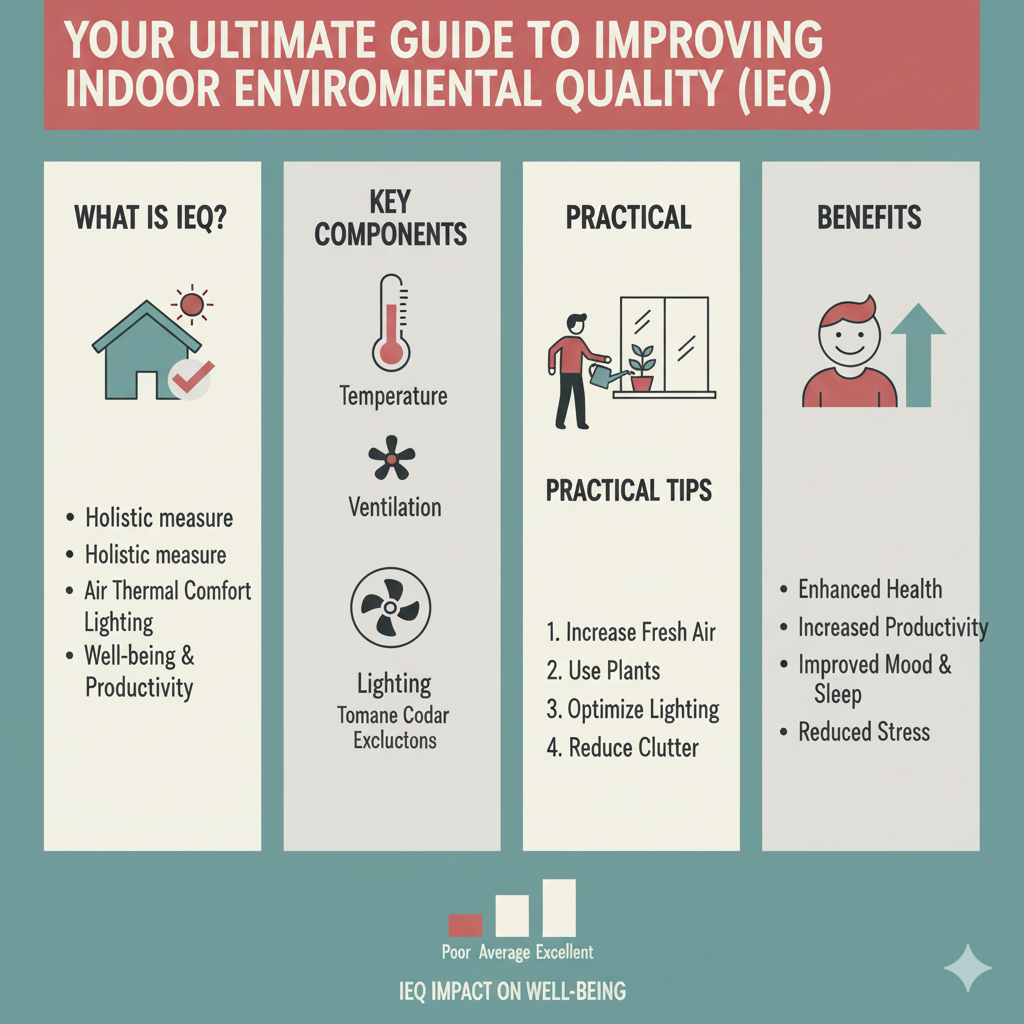Your Ultimate Guide to Improving Indoor Environmental Quality (IEQ)

Breathe Easier, Live Better: Your Ultimate Guide to Improving Indoor Environmental Quality (IEQ)
In our modern lives, we spend upwards of 90% of our time indoors. Yet, the quality of the air we breathe, the light we see by, the comfort we feel, and the sounds we hear within our homes and workplaces – collectively known as Indoor Environmental Quality (IEQ) – often gets overlooked. Poor IEQ isn’t just uncomfortable; it’s linked to a range of health issues, from headaches and fatigue to allergies, respiratory problems, and even reduced cognitive function.
The good news? Improving your IEQ is achievable and offers profound benefits for your health, well-being, and productivity. This comprehensive guide outlines actionable steps to transform your indoor spaces into healthier, more comfortable havens, optimized for both people and search engines.
Why IEQ Matters: More Than Just Comfort
-
Health & Well-being: Exposure to indoor pollutants like VOCs, mold spores, dust mites, and allergens can trigger asthma, allergies, and other respiratory illnesses. Good ventilation and source control are crucial. Learn more about the health impacts from the Environmental Protection Agency (EPA).
-
Productivity & Cognitive Function: Studies consistently show that improved air quality, thermal comfort, and access to natural light significantly boost concentration, productivity, and decision-making abilities in workplaces and schools. Research from organizations like the Harvard T.H. Chan School of Public Health details these connections.
-
Comfort & Satisfaction: Temperature fluctuations, stuffy air, excessive noise, and poor lighting create stress and dissatisfaction. Optimizing these factors makes spaces genuinely enjoyable to inhabit.
-
Property Value: Homes and buildings with demonstrably good IEQ (e.g., advanced filtration, ample daylighting) are increasingly attractive to health-conscious buyers and tenants.
Key Pillars of Indoor Environmental Quality & How to Improve Them
1. Indoor Air Quality (IAQ): The Foundation of IEQ
-
Source Control: Prevention is Key
-
Choose Low-VOC Products: Opt for paints, stains, adhesives, sealants, flooring, and furniture labeled “Low-VOC” or “Zero-VOC.” Look for certifications like GREENGUARD Gold. Check the EPA’s guide to VOCs in your home.
-
Ban Smoking Indoors: Strictly enforce a no-smoking policy inside.
-
Store Chemicals Safely: Keep paints, solvents, pesticides, and cleaning products in well-sealed containers in a garage or shed, never inside living spaces.
-
Control Moisture & Prevent Mold: Fix leaks promptly (roof, plumbing). Ensure proper drainage around foundations. Use exhaust fans in bathrooms and kitchens. Clean up spills immediately. The Centers for Disease Control and Prevention (CDC) provides essential mold prevention tips.
-
Minimize Dust: Vacuum frequently using a HEPA-filter vacuum cleaner. Dust surfaces with a damp cloth. Reduce clutter where dust accumulates. Consider using a high-quality air purifier like those from Coway or Winix for targeted filtration.
-
-
Ventilation: Dilute and Remove Pollutants
-
Bring in Fresh Air: Open windows and doors whenever weather and outdoor air quality permit (check local AirNow reports).
-
Use Exhaust Fans: Always use bathroom fans during and after showers/baths, and kitchen fans while cooking, especially when using gas stoves. Ensure they vent outside, not into attics.
-
Maintain HVAC Systems: Change furnace and AC filters regularly (every 1-3 months). Use high-efficiency filters (MERV 13 or higher if compatible with your system). Schedule annual professional HVAC maintenance. Explore resources from ASHRAE (American Society of Heating, Refrigerating and Air-Conditioning Engineers) for standards.
-
Consider Dedicated Ventilation: For tightly sealed homes, Energy Recovery Ventilators (ERVs) or Heat Recovery Ventilators (HRVs) mechanically bring in fresh air while conserving energy by tempering incoming air. Learn more about ERVs/HRVs from ENERGY STAR.
-
-
Air Cleaning: Supplementing Ventilation
-
Portable Air Purifiers: Effective for single rooms. Choose units with True HEPA filters for particles and activated carbon filters for gases/VOCs/odors. Ensure appropriate sizing (CADR rating) for the room. Consumer Reports offers independent testing and ratings.
-
Whole-House Air Cleaners: Installed within the HVAC ductwork, offering whole-home filtration. Options include high-efficiency filters, electronic air cleaners, and UV-C lights (primarily for microbial control, use with caution).
-
2. Thermal Comfort: Finding the “Just Right” Zone
Thermal comfort is highly individual but depends on air temperature, humidity, radiant temperature (heat from surfaces), and air movement.
-
Temperature Control:
-
Humidity Management:
-
Dehumidifiers: Essential in damp climates or basements to prevent mold growth and dust mites. Maintain relative humidity between 30-50%. AprilAire is a leading brand for whole-home solutions.
-
Humidifiers: Useful in very dry climates or during winter to prevent dry skin, irritated respiratory passages, and static electricity. Clean them rigorously to prevent mold/bacteria growth. The Mayo Clinic offers guidance.
-
-
Air Movement: Use ceiling fans to create a gentle breeze, making slightly warmer temperatures feel more comfortable in summer and helping distribute warm air in winter (run in reverse mode).
3. Lighting Quality: Beyond Just Brightness
-
Maximize Natural Light:
-
Keep windows clean and unobstructed by heavy drapes or furniture.
-
Use light-colored paints and reflective surfaces to bounce daylight deeper into rooms.
-
Consider skylights or light tubes for interior spaces. Velux is a well-known skylight manufacturer.
-
-
Optimize Artificial Lighting:
-
Layered Lighting: Combine ambient (general), task (focused), and accent (highlighting) lighting for flexibility and visual comfort.
-
Choose the Right Color Temperature: Use cooler, bluer light (5000K-6500K) for task-oriented areas (kitchens, offices) to promote alertness. Use warmer, yellower light (2700K-3000K) in relaxing spaces (bedrooms, living rooms) for coziness.
-
Flicker-Free & High CRI: Select LED bulbs that are certified flicker-free to reduce eye strain and headaches. Choose bulbs with a high Color Rendering Index (CRI >90) for accurate color perception. Look for DesignLights Consortium (DLC) qualified products.
-
Smart Controls: Utilize dimmers, timers, and motion sensors for energy savings and convenience.
-
4. Acoustic Comfort: Taming the Noise
Excessive noise is a significant stressor and disruptor of concentration and sleep.
-
Reduce Noise at the Source:
-
Place noisy appliances (washing machines, dishwashers) away from living/sleeping areas on vibration-absorbing pads.
-
Choose quieter HVAC systems and fans.
-
-
Block Noise Transmission:
-
Seal Gaps: Weatherstrip doors and windows to block exterior noise.
-
Add Mass & Damping: Use heavy curtains, rugs, and upholstered furniture to absorb sound within a room. Install dense insulation in walls and ceilings between noisy and quiet zones.
-
Soundproofing: For critical situations (home offices, bedrooms), consider specialized soundproofing materials like mass-loaded vinyl (MLV) or acoustic panels. Resources like the Acoustical Society of America (ASA) provide technical information.
-
-
Mask Unwanted Noise: Use white noise machines, fans, or calming soundscapes to cover disruptive sounds.
5. Building Maintenance & Housekeeping: The Ongoing Effort
Good IEQ isn’t a one-time fix; it requires consistent upkeep.
-
Regular Cleaning: Vacuum (with HEPA), dust (damp cloth), and mop floors frequently to remove dust, allergens, and tracked-in pollutants.
-
HVAC Upkeep: Change filters religiously. Schedule professional duct cleaning if significant contamination is suspected (e.g., after renovations, mold growth). Ensure condensate drains are clear.
-
Moisture Vigilance: Immediately fix leaks. Clean and dry any water-damaged areas within 24-48 hours to prevent mold. Monitor humidity levels.
-
Pest Control: Seal entry points. Store food securely. Use integrated pest management (IPM) techniques instead of excessive pesticides where possible. The National Pesticide Information Center (NPIC) offers safe use guidelines.
Practical IEQ Improvement Checklist
-
Today: Open windows for 15 minutes (if air quality is good). Vacuum with your HEPA filter. Check your HVAC filter – change it if dirty. Declutter a surface.
-
This Week: Deep clean one room, focusing on dust. Test your home’s humidity levels. Identify one chemical product to replace with a low-VOC alternative. Clean exhaust fan grilles.
-
This Month: Schedule HVAC maintenance. Inspect for leaks under sinks, around appliances, and in the attic/basement. Assess lighting in each room – can you add task lighting or replace a bulb with a warmer/cooler one? Consider buying a portable air purifier for a key room like the bedroom.
-
This Year: Consider larger investments like installing an ERV/HRV, replacing old carpet with hard flooring, adding weatherstripping to drafty doors/windows, or investing in acoustic panels for a noisy space. Get a professional indoor air quality test if you have persistent concerns.
Resources for Deeper Dives
-
Environmental Protection Agency (EPA) – Indoor Air Quality (IAQ): Comprehensive resource on pollutants, health effects, and solutions.
-
Occupational Safety and Health Administration (OSHA) – Indoor Air Quality: Focuses on workplace IEQ standards and guidance.
-
American Lung Association – Healthy Air at Home: Practical tips for improving home air quality.
-
ASHRAE Standards: Technical standards for ventilation, thermal comfort, and IAQ (e.g., Standard 62.1, 62.2, 55).
-
International WELL Building Institute (IWBI): Framework for buildings that advance human health and well-being, heavily focused on IEQ.
-
Consumer Reports – Air Purifiers & Humidifiers: Independent testing and buying guides.
Conclusion: Invest in Your Indoor Environment
Improving Indoor Environmental Quality is an investment in your most valuable asset: your health and well-being, and that of your family, employees, or building occupants. By systematically addressing air quality, thermal comfort, lighting, acoustics, and maintenance, you create spaces that are not just habitable, but truly supportive and healthy.
Start small – change a filter, open a window, switch a cleaning product. Gradually implement more strategies. The cumulative effect will be a noticeable improvement in how you feel, think, and live indoors. Remember, a healthier indoor environment means a healthier you. Take control of your IEQ today and breathe easier tomorrow.








